Weather deteriorates in Canada as powerful Hurricane Fiona approaches
Hurricane Fiona downgraded to Category 3 storm, Tropical Depression 9 forms near South America
Hurricane Fiona has been downgraded to a Category 3 storm with winds of 125 miles per hour, as Tropical Depression 9 forms near South America with an uncertain future track.
Hurricane Fiona is moving quickly approaching the Canadian Maritimes and could be one of the region's strongest storms on record.
The threat of this powerful storm has prompted Hurricane and Tropical Storm Warnings to be issued for hundreds of miles of coastline from New Brunswick and Nova Scotia to Newfoundland and eastern Quebec.
At last report, Fiona was a Category 3 hurricane with maximum sustained winds of about 125 mph. The hurricane held onto Category 4 intensity for much of Wednesday and Thursday – making Fiona the Atlantic's strongest hurricane of the 2022 season so far.
Any hurricane that is rated Category 3, 4 or 5 on the Saffir-Simpson Hurricane Wind Scale is classified as a major hurricane.
Hurricane Fiona joins three other systems currently roaming the Atlantic Basin, including Tropical Depression Nine, which could become a hurricane threat to Florida or the U.S. Gulf Coast next week, Tropical Storm Gaston near the Azores and Tropical Storm Hermine off the western coast of Africa.
Where is Hurricane Fiona?
As of Friday evening, Hurricane Fiona was centered around 200 miles south of Halifax, Nova Scotia.
The Category 3 hurricane was racing northeast at 46 mph, a track that will take the major hurricane away into Atlantic Canada on Saturday.
Wind gusts as high as 93 mph were clocked in Bermuda on Friday morning as Fiona passed by to the west.
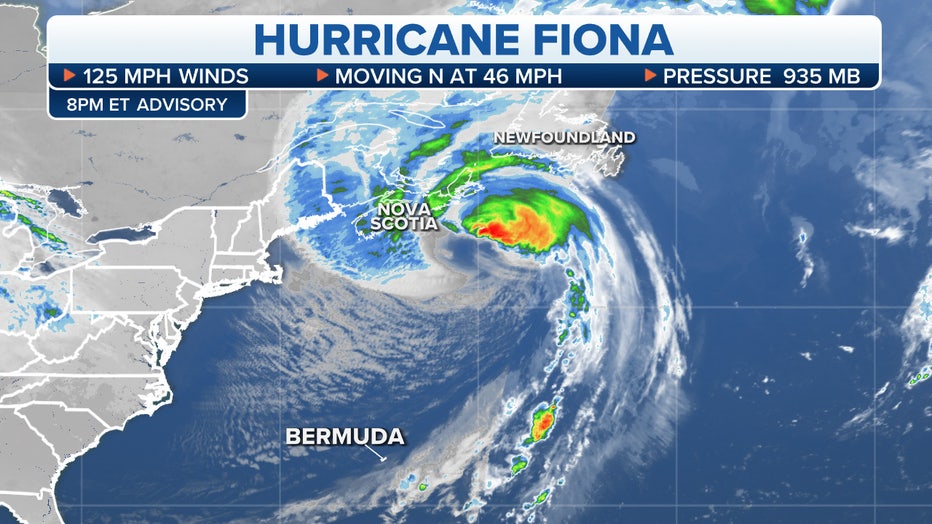
Tracking Hurricane Fiona. (FOX Weather)
Where are watches and warnings in effect?
The Canadian Hurricane Centre has issued various Hurricane Warnings, Tropical Storm Warnings and Tropical Storm Watches across Atlantic Canada. These warnings and watches include parts of New Brunswick, Nova Scotia, Newfoundland, Prince Edward Island and eastern Quebec.
WHAT TO DO WHEN HURRICANE OR TROPICAL STORM WATCHES AND WARNINGS ARE ISSUED FOR YOUR TOWN
A Hurricane Warning means sustained winds of 74 mph or higher are expected within the warning area and is typically issued 36 hours before the anticipated first occurrence of tropical-storm-force winds (39-plus mph). These high winds are likely to be accompanied by storm surge, coastal flooding and/or river flooding.
A Tropical Storm Warning means sustained winds of 39 mph or higher are expected within the warning area within 36 hours.
DRONE VIDEO SHOWS 50-FOOT WAVES AND DESTRUCTIVE WINDS IN THE HEART OF HURRICANE FIONA
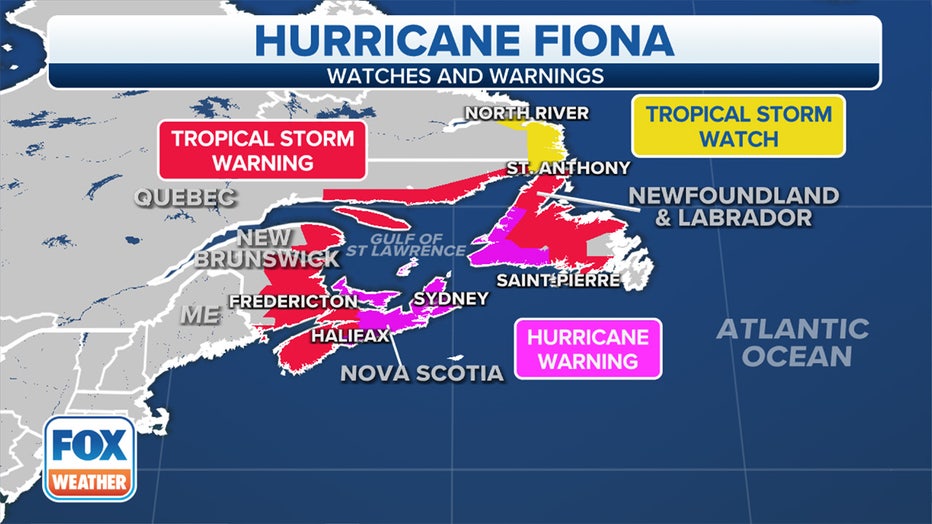
Hurricane Warnings, Tropical Storm Warnings and Tropical Storm Watches are in effect for various parts of Atlantic Canada. (FOX Weather)
What are the expected impacts of Hurricane Fiona in Atlantic Canada?
According to the FOX Forecast Center, Fiona is forecast to move toward the north or north-northeast and slam into Nova Scotia this weekend as a powerful post-tropical cyclone.
Tropical downpours could begin to arrive in Atlantic Canada on Friday before the peak rain and wind impacts spread across the region from Friday night into Saturday. Some rain and gusty winds could linger into Sunday as well.
FOX Weather meteorologist Jason Frazer noted that Hurricane Fiona's wind field is expected to expand as it approaches Atlantic Canada.
"It doubles in size to about 1,200 miles," Frazer said. "By 2 a.m., we could see some winds gusting up near 100 mph across Newfoundland, as well as Halifax, and this is going to be hanging out for at least about 10 to about 12 hours."
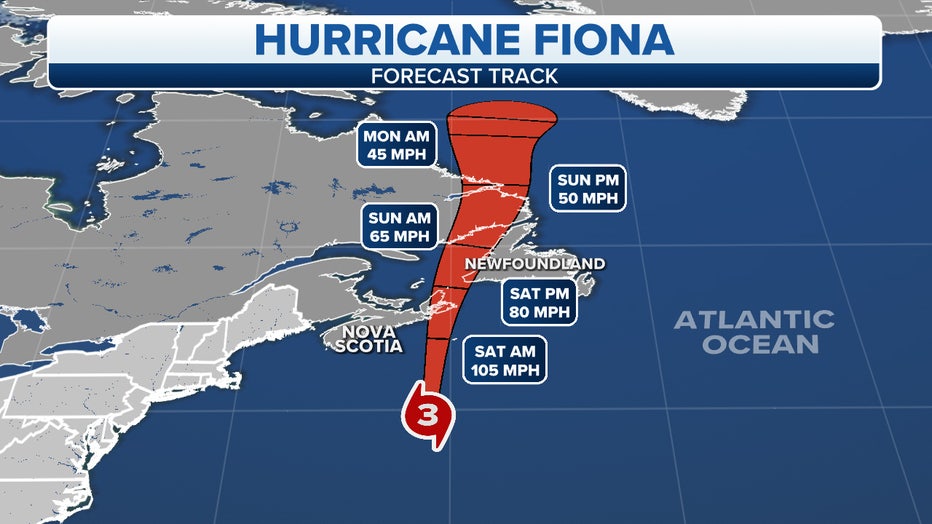
The projected path and intensity of Hurricane Fiona. (FOX Weather)
The FOX Forecast Center warns that areas from New Brunswick and Nova Scotia to Newfoundland and eastern Quebec will have threats of damaging winds, flooding rainfall and storm surge as Fiona crashes ashore in Nova Scotia.
"This storm will be a severe event for Atlantic Canada and eastern Quebec," the Canadian Hurricane Centre wrote in a statement Friday morning. "Numerous weather models continue to indicate that Fiona will transition into a very powerful post-tropical storm as it makes landfall in eastern Nova Scotia early Saturday morning. This storm will produce very heavy rainfall and severe winds."
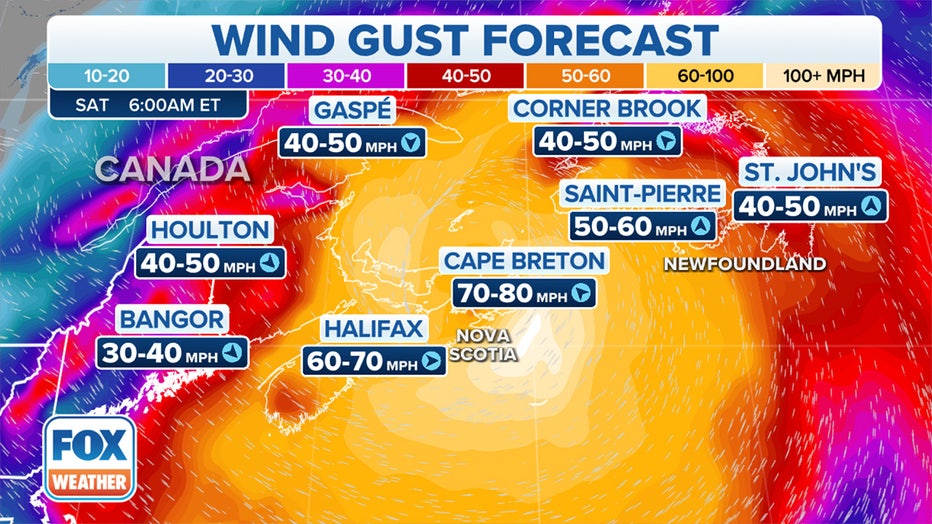
Wind gust forecast in Atlantic Canada. (FOX Weather)
Widespread, potentially prolonged power outages, numerous downed trees, structural damage, washed-out roads and significant coastal erosion due to battering waves and storm surge are all potential impacts of Fiona in Atlantic Canada, regardless of whether it has transitioned to a post-tropical cyclone or if it's still a hurricane.
According to the FOX Forecast Center, there could even be high winds capable of scattered power outages and downed trees as far west as eastern Maine and New Brunswick and as far north as Labrador and eastern Quebec.
Between 3 and 6 inches of rain, with localized amounts up to 10 inches, is predicted across Nova Scotia, Prince Edward Island and western Newfoundland. This rainfall could result in areas of flooding, some of which might be significant.
Two to 5 inches of rain is forecast for eastern Quebec and Newfoundland, while 1 to 3 inches is expected in eastern New Brunswick.
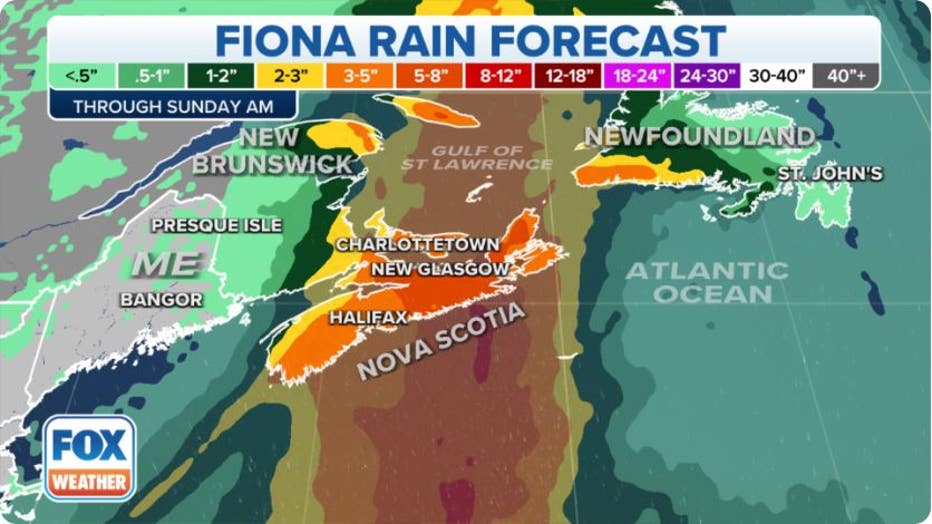
Rainfall forecast in Atlantic Canada. (FOX Weather)
The U.S. East Coast will be spared these significant wind and rain impacts, but there will be a continued risk of high surf and life-threatening rip currents along the Atlantic coastline through Saturday.
Fiona could be one of Canada's strongest storms on record
Computer forecast models indicate that Fiona – regardless of its status as a hurricane or a post-tropical cyclone – has the potential to challenge September low-pressure records in portions of Nova Scotia on Saturday, according to David Roth, a senior branch forecaster at NOAA's Weather Prediction Center.
It's not out of the question that Fiona's central pressure could even approach Canada's all-time lowest pressure, which currently stands at 940.2 millibars set on Jan. 20, 1977, in St. Anthony, Newfoundland.
In fact, according to Roth, most of the country's low-pressure records were set during intense winter storms rather than tropical or post-tropical cyclones.
But Atlantic Canada is also no stranger to hurricanes or their remnants.
Since 1951, the Canadian Hurricane Centre said the country has seen around two-dozen hurricanes or post-tropical cyclones that have made landfall along its Atlantic coast.
HURRICANE FIONA'S POTENTIAL PATH TO CANADA IS NOT COUNTRY'S FIRST HURRICANE IMPACT
The names of recent tropical cyclones to impact the expansive coastline include Larry in 2021 and both Teddy and Isaias in 2020.
Hurricane Juan of 2003 is considered to be the most destructive in recent history. The Category 2 hurricane made landfall with winds of around 100 mph on Sept. 29.
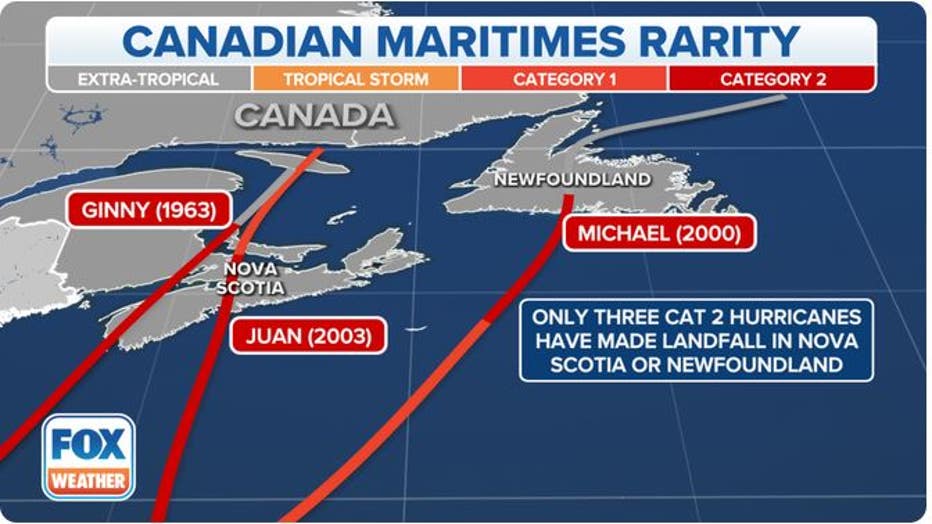
Recent tropical strikes in Canada. (FOX Weather)
Juan's winds were strong enough to knock over trees, trigger thousands of power outages, damage homes and sink boats.
Some of the hardest-hit regions were Nova Scotia and Prince Edward Island.
What are the impacts to the US East Coast?
Even though Hurricane Fiona will stay hundreds of miles off the U.S. East Coast, its indirect impacts will be felt along the Atlantic beaches from Florida to Maine.
Swells from the hurricane will continue to spread westward toward the Eastern Seaboard through Saturday.
The rough waters will increase the risk of life-threatening rip currents along beaches, and lifeguards caution less-skilled swimmers to never venture into the rough waters.
WATER FROM HURRICANES, TROPICAL STORMS KILLS MORE IN U.S. THAN WIND
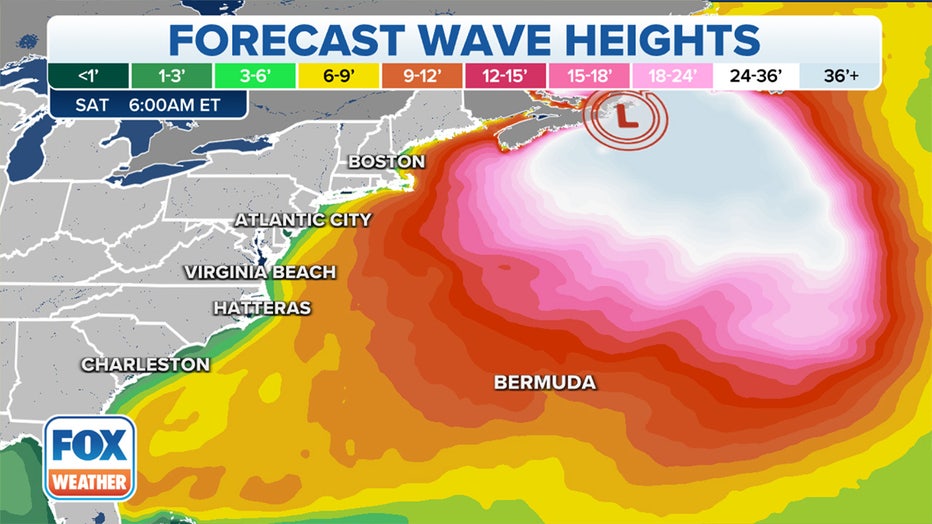
Forecast wave heights off the U.S. East Coast. (FOX Weather)
Hurricane Fiona's impacts in the Caribbean
Fiona made two landfalls as a Category 1 hurricane, the first one Sunday afternoon along the extreme southwestern coast of Puerto Rico and the second one early Monday morning in the eastern Dominican Republic.
In Puerto Rico, the city of Ponce clocked a 103-mph wind gust, while in the Dominican Republic, a gust of 98 mph was recorded in Samana at El Catey International Airport. The high winds plunged all of Puerto Rico into a blackout on Sunday as catastrophic flooding unfolded across the U.S. territory.
DEATH TOLL RISES TO AT LEAST 8 AFTER POWERFUL HURRICANE FIONA LASHES CARIBBEAN
On Wednesday, President Joe Biden declared Puerto Rico a major disaster area to help with recovery efforts.
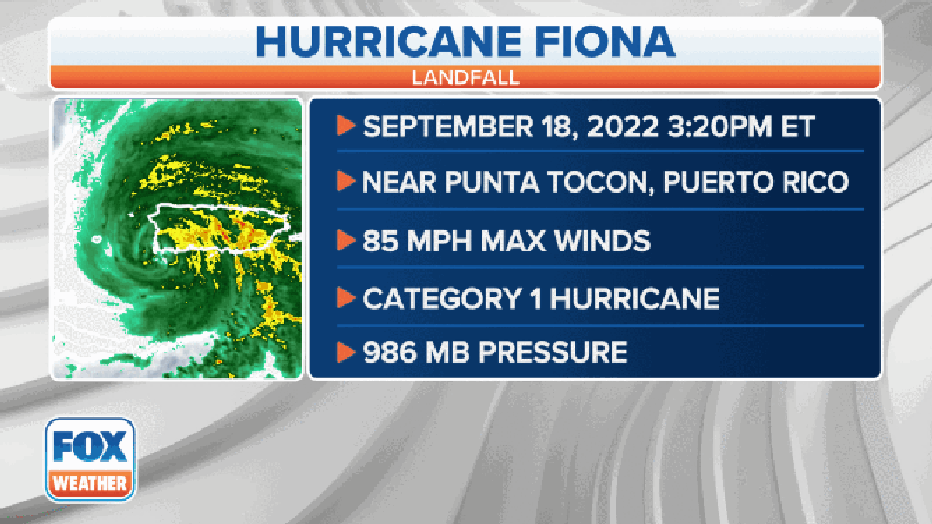
Hurricane Fiona made its first landfall in southwestern Puerto Rico on Sunday, Sept. 18, followed by a second landfall in the eastern Dominican Republic on Monday, Sept. 19. (FOX Weather)
FEROCIOUS HURRICANE FIONA BATTERS TURKS AND CAICOS ISLANDS WITH STRONG WINDS, TORRENTIAL RAIN
Hurricane Fiona battered the Turks and Caicos on Tuesday as high winds and heavy rain spread across the islands after the hurricane had already turned deadly in Puerto Rico and the Dominican Republic.
Get updates to this story on FOXWeather.com.

